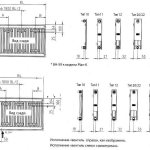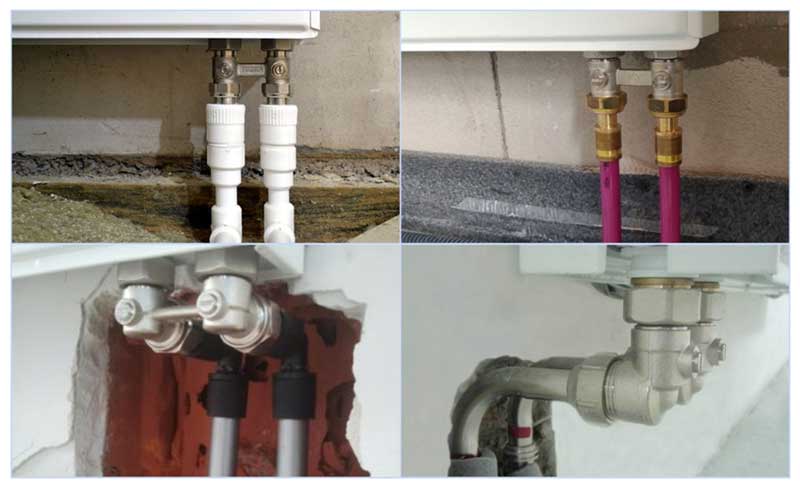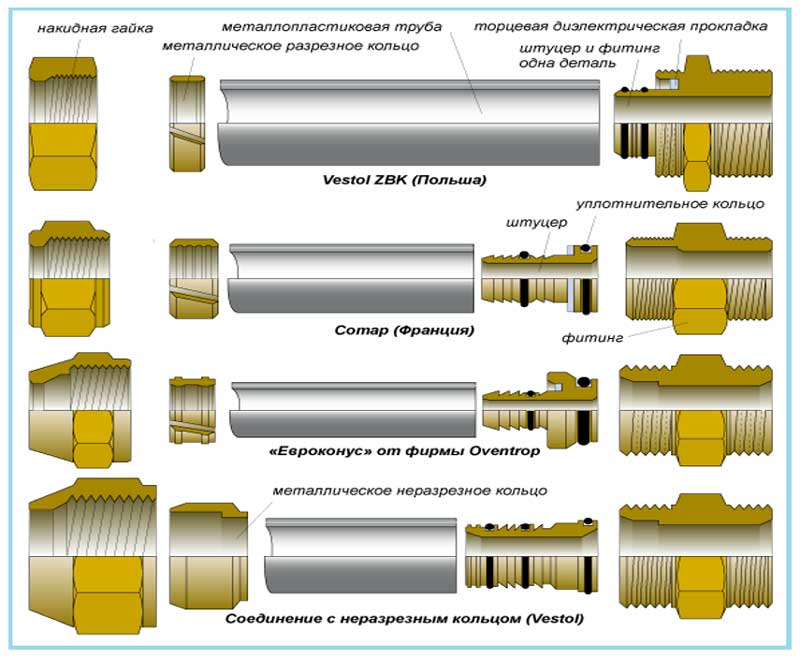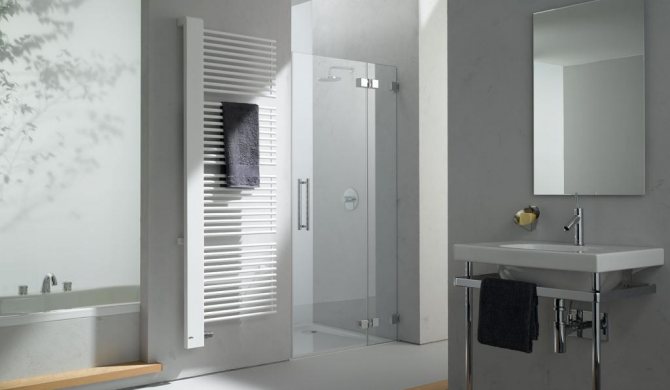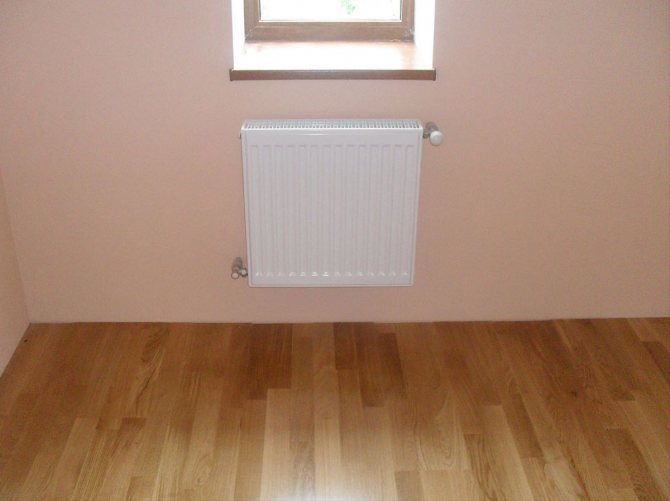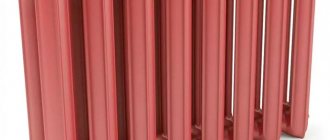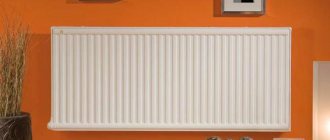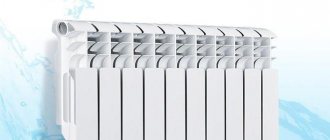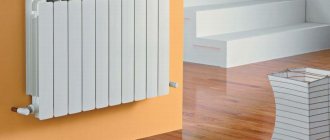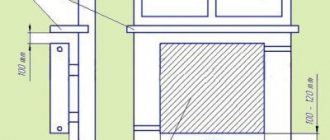Valve fittings Kermi
Kermi valve radiators are equipped with a valve insert already at the factory, adjusted to their heat output. By means of the valve inserts installed as standard, it is possible to set 8 basic positions (kv) and 7 intermediate adjustment positions. To ensure the same quality of regulation throughout the entire power spectrum, fine adjustment inserts are installed on small radiators.
Factory presets
The factory default kv values are limited to 5 out of 15 possible. The kv factory settings are designed for conventional heating systems (eg single or double family houses) with a differential pressure (Δp) of 100 mbar.
Benefits of Factory Preset Valve
Almost perfect hydraulic balancing for use in buildings up to 1000 m² (according to the certificate of the Aachen specialized institute, Prof. Dr.-Ing. Rainer Hirschberg.) KfW permits in its requirements up to 500 m² of usable area for each heating line equipped with a pump.
- Application of more favorable hydraulic compensation coefficients for the energy assessment of buildings in accordance with DIN EN 18599.
- Appreciation for the inspection of heat sources and heating systems according to DIN EN 15378 and / or DIN 4792
- Meets the terms of the current support program
- • Time savings for designers and installers due to - low design costs - low commissioning costs
- - direct positive impact on the energy passport of the building
- Energy savings of up to 6% compared to systems without hydraulic balancing, up to an additional 20% energy savings for the circulation pump
Distinctive features and advantages of Kermi valves
- The absence of step transitions in the regulation of the coolant flow allows for a finer adjustment of the valve. Advantages: - more fine adjustment is possible - better possibilities for washing replaceable modules. - less susceptible to interference
- Two different valve sizes Advantage: - Better control quality, even with small radiators
- Valve color coding according to kv value Advantage: Preset kv value - spare part (supplied fully open) can be installed without problems.
- Certification according to EN 215 (registration number 6T0002 + 6T0006)
Perfect hydraulic balancing
According to a study by the Aachen Institute, factory presets of Kermi thermostatic radiator valves in 2-pipe radiant heating systems and heated areas up to 1000 m² ensure hydraulic balance and do not require additional hydraulic balancing.
Read also: In what units is the modulus of elasticity measured?
More detailed studies have shown that these factory settings can be considered hydraulic balancing, as compared to a perfectly balanced system, the increase in energy consumption for heat transfer is only about 0.5%, which can be compared with the usual error with detailed calculation and generally accepted deviations in settings. in places.
Heating systems in which the radiators are equipped with built-in thermostatic valves with factory settings are, from a technical point of view, hydraulically balanced in terms of energy evaluation (eg according to DIN V 18599).
Adjusting heating radiators makes it possible to create the most comfortable living conditions in a residential area. The degree of heating of the battery depends both on the temperature of the coolant and on the physical volume of hot water entering the radiator. There are several ways to regulate the temperature of radiators from very good to dangerous, so before you get down to business it is better to read the quick guide outlined in this article.
The adjustment makes it possible:
- get rid of airing, which helps the coolant move around the heating system without problems;
- significantly reduce heating bills (mainly in private houses);
- do not arrange drafts, with significant overheating of the air in an apartment or a private house.
Attention! In standard panel houses with an upper supply of the heating agent, it is almost impossible to adjust the radiators.
Sizes and types of batteries
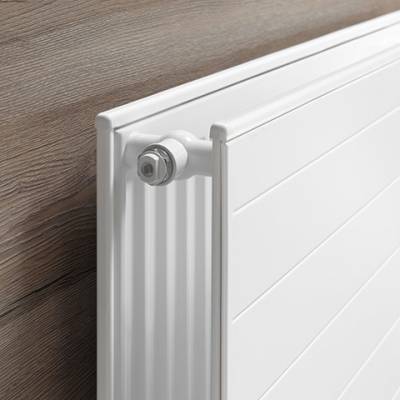
Radiators Kermi Line Series
A user who decides to purchase Kermi batteries will have to choose a suitable model, which is difficult to implement. This is due to the fact that a significant range of performance indicators requires a detailed study of the technical characteristics of each of the offered products. Particularly noteworthy is such a specific parameter as the dimensions of the case, which vary widely.
- the length of known models ranges from 40 cm to 4 meters;
- the height is from 30 to 90 cm.
In addition, steel radiators from Kermi differ in their design and can be simple tubular, panel, or have many transverse ribs. The second option, in turn, is subdivided into units that include one, two or more panels.
According to this indicator, several types of radiators are distinguished, differing in the number of sections used. All of them are summarized in the table and indicated by the corresponding numbers. In the consolidated catalog, in the form of a special designation, not only the number of constituent elements is encoded, but also a number of additional characteristics. Code 10 means one panel, and 11 - its version with an indication of the ribbed structure. Batteries under code 22 include products with two panels and double ribbing.
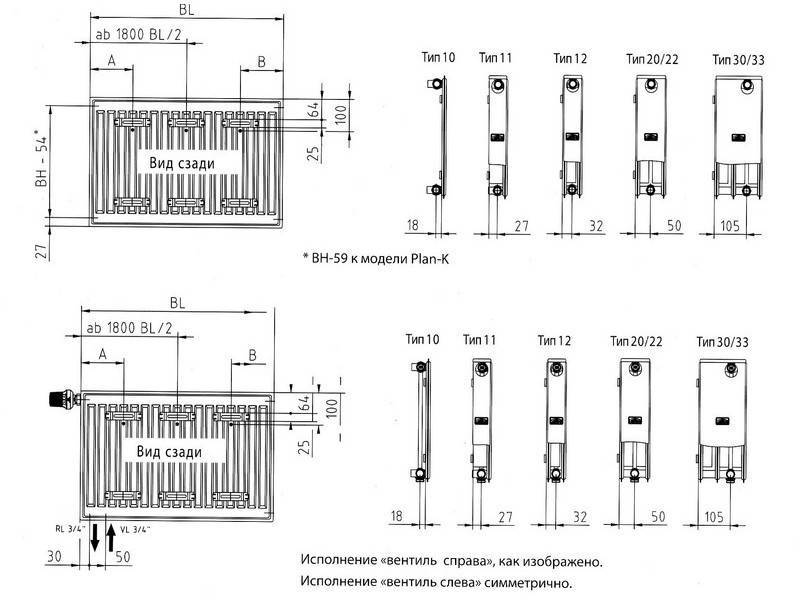

Overall dimensions of radiators
Panel radiators from Kermi are available in corrugated ("Profil" category) and smooth surfaces. The second variety is designated as "Plan" and also has various designs that differ in characteristics and generally accepted markings. The Plan-V series, for example, is referred to as FKO and is a product with bottom piping. They are known to most buyers in the following three forms:
- left-sided;
- right-sided;
- centered.
Models from the Plan-K group with standard FKV markings have side connections.


Kermi Verteo Plan
Another non-standard version of Kermi heaters is Verteo Plan or FTV. They are products of the vertical type, which are in demand in situations where the installation of horizontal analogs is impossible. These samples have a "classic" bottom connection and can be integrated into a hidden pipe system. In addition, the supply pipes for these products are allowed to be laid under the floor finish. The inner and outer surfaces of the radiators are protected by two layers of high-quality varnish.
Methods for adjusting heating batteries
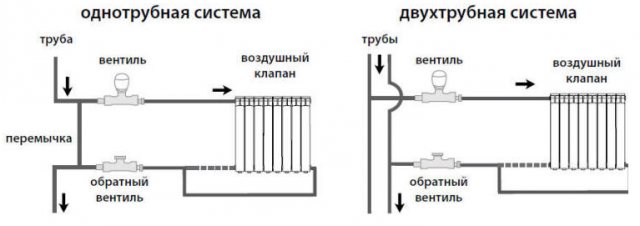

For proper heat dissipation of radiators, correct placement is an important factor. Batteries should be located where heat leakage is greatest - under windows and not far from entrances.
The heating section connection diagram also works as an adjustment of return or supply heating radiators.
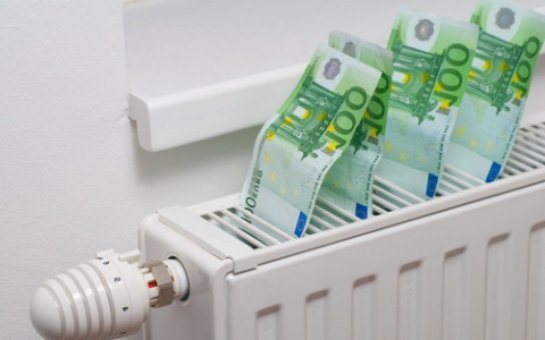

The most effective system is considered to be in which hot water is supplied from the top of the device, and the return flow is output at the bottom. Such a connection is called diagonal, thanks to this scheme, all sections of radiators receive heat evenly.
Sometimes they are connected the other way around - the supply is from the bottom, and the return is connected at the top. In this option, the loss of the coolant increases to 20% (in contrast to the first option, where the maximum is 5%). This method is used mainly in circuits with powerful forced circulation.
Losses are also high in systems with a bottom connection. Here, both the supply and return are included in the lower part of the heating device. But if the pressure of hot water is large enough, then the vortex flows created in the battery give a good effect.
In individual heating systems, careful adjustment of the return flow of heating radiators is necessary. A large difference in flow and return temperatures can lead to boiler breakdown.
Numerous videos on the Internet show detailed details of all the options for connecting heating devices.
Kermi FTV 33 models
In terms of heat transfer, these models are recognized as one of the best heaters: they are ideal for large houses, have many functions, and in general, such heating systems allow you to set different modes for individual rooms.
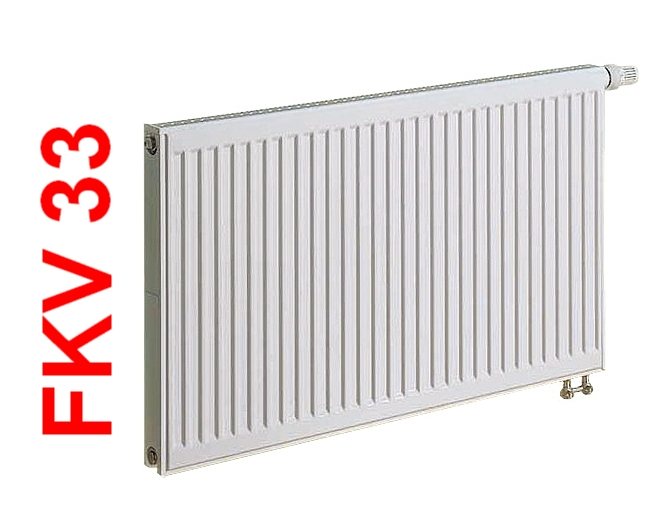

This line of heaters has the most powerful thermal conductivity thanks to three heating panels and three heat convectors.
Specifications
All kermi equipment is made from the same materials, the only difference is in the number of heaters and parameters:
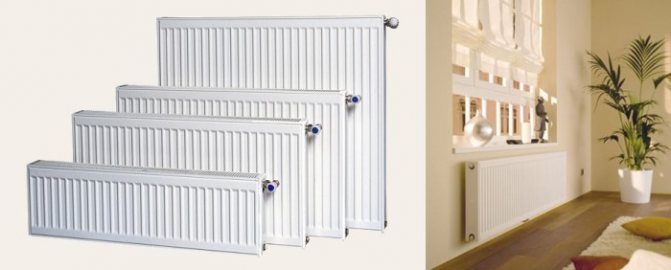

- strong steel with hydrocarbon gives strength and durability;
- good heat transfer;
- the presence of two heating pipes: supply and outlet;
- the maximum number of heating panels on the heater market;
- external U-shaped appearance;
- height - from 300 mm, width - from 400 mm, depth - from 155 mm.
The kit includes all fasteners, air vent, thermostat valve.
The cost
The price of the devices is higher than the previous models, which is due to the higher heat dissipation of the FTV 33 radiators. The approximate prices are as follows:
- the 300x1600 model with a heat transfer of 2939 W and a capacity of 8.64 liters costs 10,000 rubles;
- a 500x3000 heater with a heat transfer of 8319 W and a capacity of 24.3 liters costs 18,000 rubles;
- a 900x2000 radiator with a heat dissipation of 8782 W and a capacity of 27 liters costs 22,000 rubles.
Features of the
Heating in the radiator is carried out sequentially, which ensures high heat transfer in large rooms. Kermi models can be installed in a niche, but this requires leaving a small distance on the sides to be able to remove the end plates and grille.
Today there are many varieties of heating systems, each has its own advantages and disadvantages, features and the principle of connection, but one requirement is imposed on all of them - high-quality work. The quality and efficiency of the heating system plays an important role in every home. In the process of developing a system, one should also take into account which heating batteries will be involved in it.
For example, the owners of private houses with economical autonomous heating today are increasingly choosing inexpensive German-made KERMI steel panel radiators, and in order to reduce the cost of organizing the heating system, homeowners often install radiators themselves.
Connecting heating batteries without the help of specialists is the most common method to save money. Modern heating equipment is supplied complete with detailed instructions, following which you can quickly and efficiently connect devices with your own hands. Most often, even those who have never encountered the installation of radiators easily cope with the work. In this article, we will look at the most popular ways to connect steel radiators.
Options for increasing heat transfer
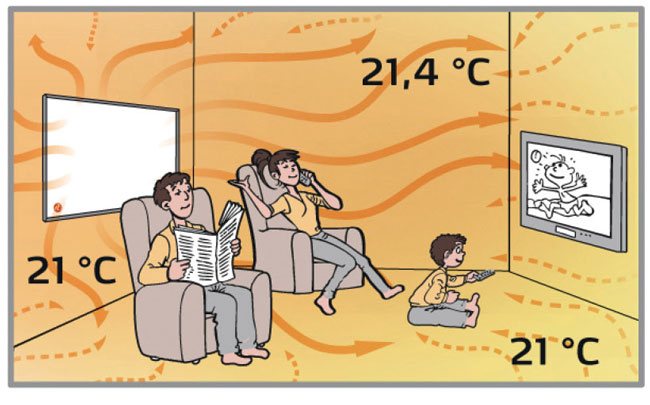

Any regulating device is capable of lowering the temperature of the battery. It is impossible to force the radiator to give off more heat. If the batteries in the apartment are cold, and the temperature in the room does not meet the standards (for corner rooms it is + 20-22, for the rest - +18), you can try to change it in the following ways:
- try to remove air plugs in batteries and clean pipes and filters;
- analyze the connection diagram and possibly change it;
- add the required number of radiators.
I would like to dwell on the last point. When the comfort in the apartment is at stake, it is advisable to avoid mistakes in the choice of radiators, because it will be impossible to change anything.
Purmo steel panel devices show good results. The built-in convection elements of these batteries provide accelerated heating of the room; they can be used in both one-pipe and two-pipe heating options.
A worthy competitor to them is the RIFAR Base company, which presents a whole line of bimetallic and aluminum radiators. These batteries are able to withstand high pressure and perform their functions normally with significant surges in heating networks. The heat transfer percentage of these heating devices is very high. The RIFAR Base 500 model is the most powerful in the range of bimetallic devices, and is intended for heating large rooms with poor thermal insulation.
German radiators Kermi deservedly enjoy a good reputation. They are steel or bimetallic. Three types of metal of various thicknesses are used for production. Heating technology "Kermi" is mainly suitable for installation in cottages and private houses.
Design features of Purmo radiators
For the manufacture of batteries, steel is suitable in many parameters, it is a flexible and malleable material, with high strength it can be easily welded, its manufacturability has long been tested in various products of the heating system. Steel panel batteries
are made of two types:
- tubular radiators;
- panel varieties of flat batteries.
Panel type
First, blanks are made for the manufacture of the device. Two flat steel purlins are welded together along the contour for strong adhesion. When creating the device, two or three of these resulting panels are stamped together. Inside, oval cavities-passages are obtained for moving the heating fluid. The finally finished parts are connected to each other using pipes.
To increase heat dissipation
from the inside out on the panels, they put U-shaped ribs, which are made of thinner steel than the plates. This design successfully enhances convection. The complex connection of several plates is covered from the outside with a special casing.
The types of Purmo panel heating radiators depend on the number of connected converter and heating plates inside the flat device. Owners of private houses most prefer to install Purmo flat radiators with only air heating function, without converter communication. Such panel radiators are small in thickness, which makes it possible to mount them without reducing the usable area of the room.
Tubular Purmo Radiators
These models are referred to as tubular products if the core of the panel radiator is welded pipes
and is at the same time a body. In the manufacture of such a radiator is more complex than the panel type, but there are a lot of models. Consumers most often prefer the choice of the classic common option, when the radiator is similar to old cast-iron models, but inside there are many more passages for the movement of the heating fluid.
Radiator price
Purmo is quite significant, this type can be attributed to elite models and cannot be called budgetary.Designers working on a grand scale of creative thought in tandem with a flight of imagination can afford an original design, where a panel radiator will act as a highlight of an expensive interior.
Adjustment devices - taps, valves, automation
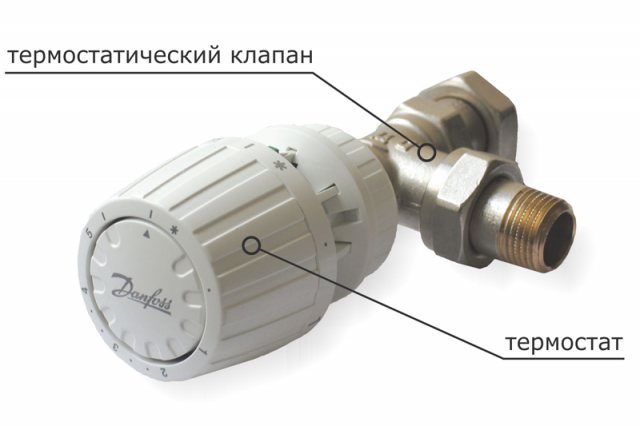

Adjustment of heating radiators in an apartment, in the country, in a mansion directly depends on the quality of the control valves.
A shut-off ball valve with a large stretch can be classified as a regulating device. It cannot provide a stable thermal regime; such a device requires constant manipulations during adjustment.
Important! This crane must always be in one of the extreme positions. In an intermediate position, its seal becomes unusable and it leaks.
.
Read also: How to connect a single circuit breaker
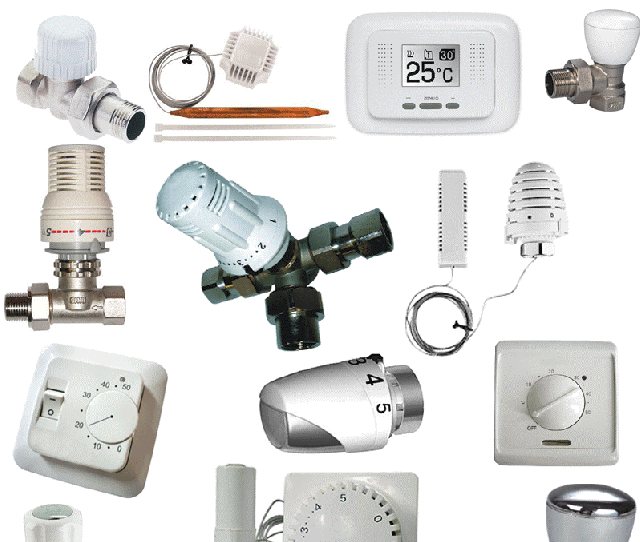

The hexagon valve can change the amount of hot water supplied to the battery. This is achieved by changing the valve bore. Its valve is mechanically linked to a dividing scale on the handle. The scale marks are used to set the optimum temperature. Such valves are very inexpensive and reliable enough, but they require constant monitoring.
The automatic thermostat itself changes the heating temperature of the radiator depending on the room temperature. This process is commanded by a temperature sensor.
Thermostatic thermostats are very similar to a manual valve, while a thermostatic head is mounted on the valve valve, which controls the operation of the valve.
The most perfect is the electronic thermostat, it has the largest set of functions. Devices of this type allow you to program their operation by setting the required temperature at different time intervals. The control panel of such a thermostat is equipped with a convenient display with buttons.
Important! In standard high-rise buildings with a centralized heating system, the water in the system contains impurities that clog the thermostats. Therefore, when installing automatic regulating devices, it is necessary to install special filters in front of them. This protection requires constant maintenance.
Thermostats can not only maintain a comfortable room temperature, but also reduce the cost of heating the coolant.
Today, the rate of generated energy resources, which are spent on heating and ventilation of structures, reaches 40 - 45%. Unfortunately, in our country this value is several times higher than in more developed countries.
In this regard, oddly enough, the problem of energy saving is one of the most acute and discussed. It is also worth remembering that the cost of energy for household purposes is constantly growing.
There are a huge number of ways to save on electricity, but this article will focus on heating radiators and thermal heads, which can significantly reduce the cost of maintaining heat in the house. But, it is necessary to choose the right thermostat for your heating system, as well as to install them correctly.
Basic specifications and features
The side surfaces are protected by special safety elements, the top surface is covered with a bar. Two bottom holes for connection at floor level and four on the side. All holes are threaded G 1/2 ″. The battery looks modern and even stylish somewhere.
Purmo Hygiene radiators are panel batteries without convection and safety elements, mainly intended for use in medical facilities, as well as in the food industry, and in other facilities with increased hygiene requirements. Side holes in each corner of the radiator with internal thread G1 / 2
All Purmo heating elements are made of 1.25 mm cold-rolled steel, and only the Planora series has wall thicknesses up to 2 mm.
The metal parts of the device are painted using high technology cataphoresis of the second generation, electrostatic spraying.
This significantly improves corrosion resistance. At the final stage, the products are covered with snow-white epoxy enamel (according to the RAL-9016 scale), but on an individual order, you can paint a batch of goods in any shade.
During the manufacturing process, radiators are specially tested for tightness by creating a strong pressure in the system, up to 12 atmospheres. It is important that complete drainage of the coolant from the battery is excluded. During the operation of radiators, its losses should not exceed 10%. So, if you need to repair a limited section of the heating system, you should drain the water only from the segment being repaired, but not empty the entire system.
It is impossible to create an efficient heating system without quality radiators. It is on this element that fast and uniform heating of the room depends. Finnish Purmo radiators have all the technical characteristics necessary to create a comfortable microclimate in the house.
Thermal head: working principle
The thermal head is a special device that is needed to adjust the temperature in the radiator. The first versions of such heads appeared back in 1943, developed by the DANFOSS company.
Several decades have passed since the appearance of the first thermostatic heads with a remote sensor. Naturally, as is the case with any other technique, during this time the product has undergone a huge number of changes, as a result of which the quality and accuracy of thermostats has increased. Their design consists of only two main parts: a valve and a thermal head. They are connected by a special locking mechanism.
The very principle of the mechanism looks like this: the thermal head constantly measures and analyzes the temperature of the radiator and affects it with a valve that opens and closes the flow of water into the radiator.
This method of temperature control is called quantitative, since the mechanism changes the amount of coolant that passes through the heating radiator. There is another method called quality. The point here is to regulate the temperature directly in the system itself. This issue will help to solve a special mixing unit, which is installed in the boiler room.
Radiator connection options
After choosing the model, class and type of radiator, it is necessary to determine the method of connecting the devices to the heating system of a private house. Connection system
subdivided into one-pipe and two-pipe:
- side connection in a two-pipe system;
- bottom connection in a two-pipe system;
- side connection in a one-pipe system;
- bottom connection in a one-pipe system;
- thermostatic valve or valve application.
One-pipe system at a glance
A single-pipe system refers to the type of system when water under pressure is supplied upward to the last floors, and then through other pipes it enters the lower floors. At the same time, it simultaneously passes through all the heating registers installed on the way. On the lower floors there is temperature difference
downward.
If you try to regulate the water supply, it will not bring significant changes. It is not recommended to install pipes of a larger cross-section, as this will lead to a decrease in the flow of the coolant in the riser.
How to choose the right thermostatic mechanism for a radiator
When choosing a thermal head, it is necessary to take into account all the features of the installed heating system. Taking into account these features, as well as the installation conditions of the radiators, a wide range of combinations of heads and valves opens up.
For example, if your heating system is identified as a one-pipe system, valves with the maximum water flow are best suited, as with two-pipe systems in which water moves naturally without any mechanical intervention.
But if a two-pipe radiator is used, the supply of water in which is due to the circulation pump, then it is best to select a valve with regulation of this very supply.
After the correct decision on the choice of the valve has been made, you can proceed to the thermal head itself.
There are five most common and affordable options. thermal heads from Kermi, which can be purchased, namely:
- consignment note with an internal thermoelement;
- electronic with the possibility of programming;
- with an external temperature sensor;
- anti-vandal;
- thermal heads with external regulator.
Classic thermal heads, in which the temperature sensor is installed internally, are installed in cases where the axis of the device is in a horizontal position after installation.
Many professionals recommend do not install the thermal head vertically on the heating radiator. The fact is that the heat that comes from the radiator will strongly affect such an installation, as a result of which the device will almost 100% not function correctly.
If for any reason it is not possible to install the head horizontally, you can use a special remote temperature sensor, which is attached to the capillary tube.
Read also: Who and how improved the incandescent lamp
There are other reasons for installing an external temperature sensor, namely:
- If the radiator will be located behind curtains.
- If there is another heat source near the thermal head.
- If the battery is located under a large windowsill.
With regard to electronic sensors with external display and programmability, they are also of two types:
- with built-in control unit;
- with a removable (external) control unit.
Devices with a removable control unit can also continue to work after it has been separated from the structure, which is not the case with the option with a built-in unit. However, naturally, the price of the second option is slightly higher..
These types of thermal heads can significantly reduce the price of electricity, since they allow you to adjust the temperature in different modes and at different times of the day. Thus, the heat level can be reduced during the day and increased at night.
Anti-vandal devices will be a great solution for homes with small children. As we all know, children always love to touch and twist everything. And this is not always safe for both children and the mechanisms themselves in the house. Vandal Proof Thermostats will protect the settings of the mechanism from vandal actions performed with them. In public buildings, oddly enough, such thermal heads have also become widespread.
Advantages and disadvantages of Purmo radiators
For the manufacture of Purmo radiators, high-strength steel with a thickness of 1.25 mm is used. Products are painted using the technology used in the automotive industry. Radiators are immersed in a container with a primer solution, and then a special paint is applied under the influence of an electrostatic field. This technology allows the coating to firmly adhere to the steel surface, which completely eliminates the possibility of peeling and swelling of the paint during temperature fluctuations. Products are painted white, but there is a possibility of painting on an individual order. To select a color, the customer is provided with a palette of 700 shades.
Purmo products have a wide range of benefits:
- efficient heat transfer due to natural convection and infrared heat radiation;
- the simplicity of the design ensures a long service life, since there is simply nothing to break in the device;
- various options for supplying heating pipes allow the installation of radiators in any conditions;
- Purmo radiators are lightweight and do not require massive brackets during installation;
- due to the small internal volume of the devices, high efficiency of the heating system as a whole is achieved;
- the cost of metal radiators is much cheaper than similar aluminum products;
- the aesthetic appearance of the radiators harmoniously fits into the interior of any room;
- Purmo radiators have a universal design that allows them to be used in one- and two-pipe heating systems;
- high-quality paintwork reliably protects the outer surface of radiators from corrosion;
- it is possible to choose a color in accordance with the design of the room.
Disadvantages of Purmo radiators:
- in centralized heating systems, service providers drain the coolant for the summer period; if air enters the device, the metal can corrode.
- due to the presence of a large number of welded seams, radiators do not withstand water shocks well, which imposes restrictions on their use in heating systems operating under high pressure.
Purmo monitors the quality of products at all stages of production and is constantly looking for ways to improve products. All Purmo products are standardized and certified.
For the installation of an efficient heating system for both private houses and apartments in multi-storey buildings, Purmo radiators are used to distribute heat at the final stage of the heating process. They are the ideal solution for district heating systems in terms of technical, economic and hygienic solutions. The auto-adjustment devices, which are equipped with all modern indoor heating systems, work very fruitfully with the devices of this company, due to their low inertia and small volumes of liquid.
The advantage of Purmo radiators is that they react very quickly and efficiently to automatic control signals, differ fast heating and cooling
after work. The only rejection for the installation of flat devices are rooms with high air humidity, but this limitation is considered for models without special anti-corrosion protection of the surface.
Today determines the popularity of Purmo radiators as the highest quality and most reliable devices for installation in heating systems. They are equally relevant for heating domestic and industrial premises. Flat batteries are so varied in design and specifications that they can be easily matched to any design solution. For ease of installation, models are available with side and bottom connections, in various depths, lengths and heights.
Purmo radiators
are perfect, since they allow a working pressure of up to 10 atmospheres, while flat devices are tested at a pressure of 12 atmospheres, and a safety margin is obtained. For heating small and large areas, you can choose respectively flat heaters of the required power.
The name of the radiators Purmo comes from the name of a small town where the production of radiators at the first factory began. Further cooperation of manufacturers was continued with the Rettig concern, which paved the way for the sale of radiators abroad. Since then, large production facilities for the production of flat batteries have been opened in Germany, Poland and Finland. The entire modern world has appreciated the quality of batteries, and they enter the markets of about 20 countries.In Russia, flat radiators have also gained popularity due to their well-proven reliability and efficiency at, respectively, a very reasonable price.
Purmo radiators are manufactured from modern cold rolled steel alloys
low carbon. To give the outer surface beauty and shine, as well as to protect against corrosion, two layers of varnish are applied to flat products, which is very durable in operation. For the coating, the cataphoresis method is used, which is a guarantee of color consistency and film integrity. In flat radiators, the convection system is very well thought out, which allows them to be used in different rooms without special costs.
Installing a thermo head on a heating radiator
As mentioned earlier, the installation of the thermostatic valve is best done in a horizontal position relative to its axis.
You also need to know that there is no need to install mechanisms on absolutely every battery in your heating system. There is a rule that has been formed over decades. It sounds like this: only those radiators need to be adjusted, which in total have a little more than 50 percent of the total capacity of the system. For example, if in the house has only 2 heating radiators, you need to choose a powerful one and install a thermal valve on it.
It should also be borne in mind that if we are talking about cast-iron radiators, then the use of a thermostatic valve will be as ineffective as possible, that is, useless. The reason for this is that such radiators are inert, which leads to a long adjustment delay, from which there will be no sense. Therefore, installing thermostats on cast iron batteries is a pointless exercise.
It is best to mount the valve on the supply pipe when it is connected to the general system. If this happens in an already assembled heating system, then dismantling of some elements and cutting pipes cannot be avoided, which will lead to great inconvenience.
After the valve has already been installed, the thermal head is installed very easily by aligning the corresponding marks on the material housings and fixing the device with a gentle push, followed by a click, which serves as a signal that the mechanism is firmly fixed on the valve.
It is much more difficult to install the anti-vandal regulator, which was discussed above. At the very least, you need a 2mm hex wrench. Using dowels, it is necessary to fix a special mounting plate in the wall, and then fix the body of the mechanism itself on it. Next, you need to install the capillary tube to the wall using ordinary plastic clamps. And only after that you can fix the thermal head itself with a key.
On the back of any thermostatic regulator, you can find restrictive fonts that serve to set the maximum and minimum temperature of the water in the radiator.
Additional recommendations for installing thermal valves:
- Under no circumstances should direct sunlight be allowed on the body of the mechanism. This will damage the thermostatic head very quickly.
- Any interior items should not overlap or hide the thermostatic element from the rest of the room. If we make this mistake, the air temperature near the mechanism will be an order of magnitude higher than in the room. Also, the thermostat must not be positioned above rising heated air currents. For example, it cannot be placed directly above the radiator.
- The possibility of any kind of pressure on the thermostatic valve arising from the connected piping must be excluded.
What is included in the set of Kermi radiators with bottom connection
The complete set of models of radiators of this type includes a thermostatic valve, the main function of which is to automatically adjust the temperature of water and air in the room. And the additional purchase of a thermostatic head will reduce energy consumption for heat generation by up to 30%.
Usually the radiator connections are located on the right, but if there is a need, it is possible to release a modification with a left-hand connection at the buyer's request. The complete set of the FTV radiator includes a Mayevsky valve, plugs and fasteners.
You can buy Kermi radiators at the best prices at any time on the website of the online store DomKermi.ru.
